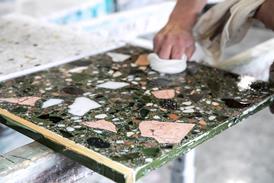Estridge, which won the USA’s National Housing Quality Award last November, doesn’t sell houses or lifestyle, it sells community. The National Housing Quality Award recognises Estridge for its treatment of employees, subcontractors and customers, and for the way it makes a profit from, rather than despite of, this focus. Winning the US’s most rated prize was celebrated with a cruise holiday for 240 staff and their partners that set the company back $300 000.
Altruism? Absolutely not. The company has a reputation for quality that converts to 95% of its customers saying they would be willing to recommend buying an Estridge home to a friend, and about 40% of completions come from sales staff converting those referrals. Referrals helped the company to sell 500 homes last year at an average unit price of $190 000, giving it a turnover near $100m. The private company is tight-lipped about how much net profit that yields but it is characteristic of the Quality Award winners to be twice as profitable as their competition.
The company has achieved this against a background of change and growth. In the mid-1980s, company president Paul Estridge Junior took a small business founded by his father to develop a handful of custom-made homes a year for the luxury market into production homes, the US’s standard product. Today it still offers customised homes, but the bulk of its business comes from its five product lines: the 400, 450, 600, 700 and 900 series, developed in sites of a minimum of 120 units. It expects to be building 900 homes a year within four years.
Develop the reputation of having the home ready first time every time
Charlie Scott, Estridge Homes’ executive vice-president
The move towards being a customer focused company was spurred on by Estridge Junior’s faith in the principles of US industry’s management gurus and a determination to lead by example. The management team he picked to help him orchestrate that evolution would be hard for any housebuilder to replicate: he went to college with most of them, including fellow student Charlie Scott, now executive vice-president.
Last month Scott spread the US customer care gospel to UK homebuilders at a Building Homes-sponsored conference in Leicestershire, where he impressed with how the customer care philosophy impacts on staff, subcontractors and customers. Scott says the company’s high referral rate does not eliminate the need to market schemes through advertising in local newspapers or even the company’s enlightening website. “Referrals are assurances from a friend. Buyers still need to find the location,” says Scott.
Ever seen a mission statement like Estridge’s?
- Daring to walk in the past, while soaring into the future.
- The Estridge Group is not only a group of people but also a group of beliefs. The cornerstone of these beliefs may be unconventional to most companies. Quite simply, old fashioned down to earth values like the golden rule - “Do unto others as you would have others do unto you” - typifies our sincerity. Building homes like those we would build for our own family, we fearlessly adhere to these convictions allowing everyone to profit.
- We realize we are not perfect. This understanding combined with our beliefs and commitment, will allow us to lead the way. Always knowing...There is no finish line.
Getting the best out of staff
We don’t expect our employees to treat customers any better than we treat them,” says Scott. So, the company took a long, hard look at the way it conducts itself, and made changes, like moving its financial year end from 31 December to September so staff do not have to work overtime for the sake of Estridge’s profit when they really want to be spending Christmas with their families. On a day-to-day level, Estridge is open and honest with its 140 staff, sharing all financial information with them, except salary details. It invests in its staff through training at all levels, hiring consultants, running a professional development course - for which employees pay $75 for course literature themselves - and stocking a library with videos on personal issues like how to deal with bereavement. The focus on personal problems as well as professional ones is strategic. “We find that most performance problems come from concerns outside the workplace,” says Scott. Much of the training is geared towards “creating an attitude and acceptance of change,” says Scott. Having hit the target of the housing quality award, staff are now working towards the goal of another award, in the spirit of continuous improvement.Managing the feelgood factor for homebuyers
In handling buyers, the homebuilder’s objective is not to pander to the buyers’ every whim, but to manager their expectations. It does this by two routes: a clearly defined series of meetings and a literature pack. Once buyers have made their reservation, they are invited to customer orientation sessions, billed as “pizza parties”, that explain what will happen on the road to home occupation. Attendance at these sessions means buyers are unlikely to complain at a later stage of lack of communication, an accusation that had been levelled by Estridge customers in the past when sessions were poorly attended. The incentive of a $200 gift voucher for garden maintenance is sufficient incentive to ensure buyers now attend. This meeting is followed by a features and finishing orientation meeting to introduce finish choices, a decision-making finalise features meeting, a colour selection meeting, and a plan review meeting to review the finishes, the build schedule and resolve any questions. Accompanying literature makes buyers clearly aware of their responsibilities, pointing out for example that buyers should “beware the cycle of emotional highs and lows you will experience as you proceed through the construction process”. Options like conservatories each has a clear list price. The homebuyer makes three visits to their home during build, including putting soil from their plot into a jar to mark the start of building, and can record each visit with a camera offered in the sales information centre. From this point on, buyers’ queries are routed through a customer communication centre, which takes some 3000 calls a month. New owners’ complaints about problems with their home have to be dealt with swiftly: the communication centre faxes details and pages the site worker who then has 15 minutes to make contact with the homeowner. Problems must be addressed within 24 hours. “Fast response drops customer anxiety levels to zero,” says Scott.Subcontractors and suppliers: play by the rules - get the rewards
Subcontractor and supplier relations are geared towards meeting Estridge’s golden rule of construction: “Develop the reputation of having the home ready first time every time.” It treats subcontractors well, but in return demands high professional standards. The homebuilder’s attitude is ruled by “the 3Ps: pay fast, pay fair and pay attention to what they say”. It tells subcontractors exactly how well it is paying them, by giving them comparative data on what others are paid, and surveys them for views. Every subcontractor arriving on an Estridge plot will find an expectation sheet, that distills the subcontractor’s work and Estridge’s expectations each into four simple points. “When we inspect the house we take the subcontractor with us,” says Scott. “We work together to solve problems.” A quality assurance audit has a list of more than 300 items to be checked before each home can be considered complete, and some items cover several procedures, for example checking the living room floor involves taking into account such factors as level, squeaks, seams and scratches. The company’s monthly newsletter names the members of the 100% club - subcontractors producing a month’s perfect work. “The names are not posted to punish those who aren’t perfect, but as recognition for good work,” says Scott.Source
Building Homes




















